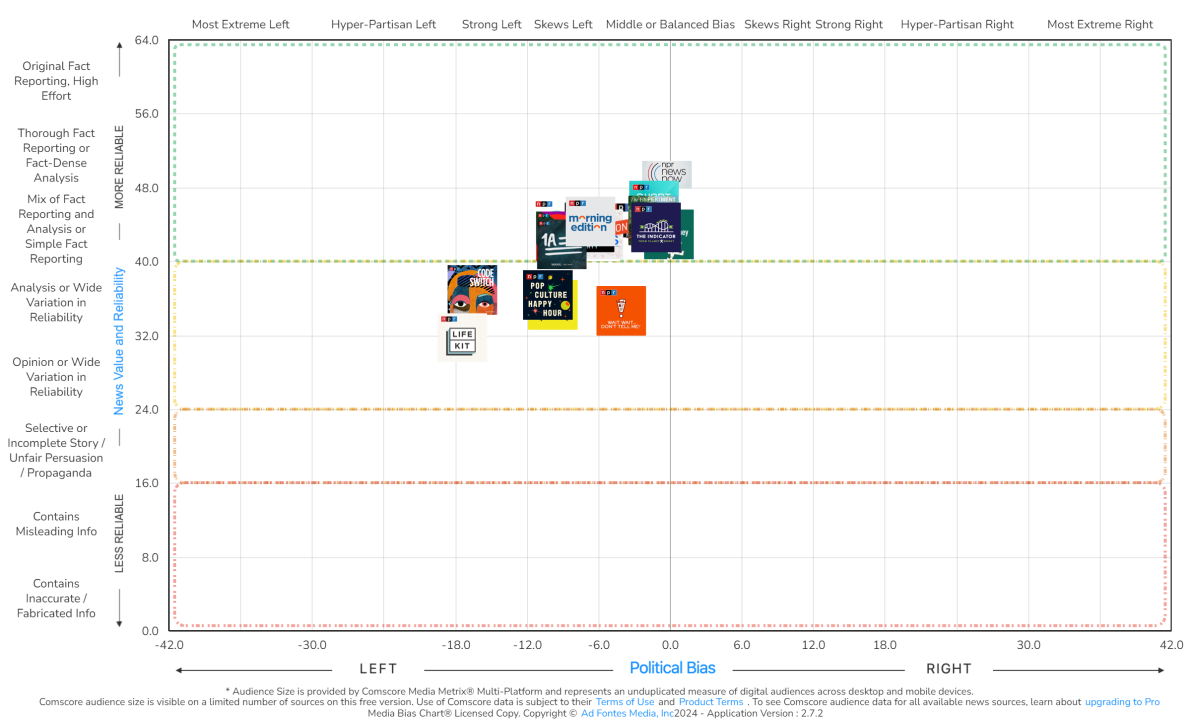Menu

The Free Press NPR Article and the Relationship Between Bias and Trust
Ad Fontes Media founder responds to NPR debate
Author:
Vanessa Otero
Date:
04/11/2024
A bunch of people sent me this article yesterday so I thought I’d weigh in on it from Ad Fontes Media’s lens on bias–especially at large, long-standing publications–and how it relates to trust.
https://www.thefp.com/p/npr-editor-how-npr-lost-americas-trust
If you missed it, a senior editor at NPR, Uri Berliner, wrote a piece in The Free Press asserting essentially that NPR’s left-leaning bias has increased over the years, which has led to a decrease in trust.
NPR published a response which quotes its chief news executive defending its journalism while welcoming discussion and critique around how it should best serve its mission and the public.
https://www.npr.org/2024/04/09/1243755769/npr-journalist-uri-berliner-trust-diversity
The challenge of trust Uri Berliner describes is not unique to NPR. I characterize the issue succinctly as this; more bias results in less trust.
When I talk about bias, I am specifically referring to left-middle-right US political bias, which takes the form of things like political position advocacy, platforming of political actors, language characterizing political issues and opponents, topic/fact selection, and topic/fact omission. It is possible to do fact reporting, even on controversial topics, while minimizing bias along these measures.
Let’s look at three things: 1) NPR’s actual level of bias and 2) why more bias results in less trust and 3) how we can collectively reverse this trust decline
1. NPR’s actual levels of bias: Responses online about the degree of NPR’s leftward bent ranged from vehemently agreeing it had gotten very biased to vehemently disagreeing, saying NPR was barely biased at all. Our data shows that depending on what examples come to mind when you think of “NPR,” each kind of commentator would find something in support of their view.
On our chart, NPR’s online digital (i.e., written) content is high in our reliability section and just a little left of the midline, about four points. But most people know National Public Radio for its audio content. While it has a couple of shows on the midline like NPR News Now, the top-of-the hour, 5-minute news update, most of its audio programs range from skews to strong left, including popular ones like 1A and UpFirst. Nothing falls to the right of the midline. So, overall, NPR does lean decidedly left according to our methodology.
2. Why more bias results in less trust: In the last 8-10 years especially, large, big-name newsrooms who have historically been committed to “objective-as-possible” fact reporting have made coverage and content decisions that lean into the bias of one side or another (or sometimes into the bias of both–several large outlets have experimented with mixing in both left- and right-leaning columnists in the same paper–but usually it’s to one side).
Leaning into more bias is usually done under the justification of “including more perspectives and voices,” or “standing up for democracy/free speech/truth” but in practical terms, accepting higher levels of bias simply results in a higher volume of analysis and opinion content by writers and more platforming of political guests’ analysis and opinions on radio and TV programs. Conveniently for publishers, analysis and opinion content often gets rewarded with more reader engagement.
The problem with fact-reporting newsrooms tolerating higher volume and degrees of bias in their analysis and opinion content is two-fold:
- The biased analysis and opinion content itself wins favor with one faction but reduces trust from most others. In NPR’s case, it increased favor (different from trust) with more left-leaning audiences but reduced trust with center and right-leaning ones, as Berliner indicates.
- When the overall bias of the content creators (beat reporters, writers, editors, hosts) in a newsroom leans all one way, it becomes easier for the bias to make its way into the traditional fact-reporting content. Bias, even a little, makes you miss stuff. It makes you less skeptical of stuff you like to hear and more skeptical of stuff you don’t. The more bias in the publisher overall, the more misses on the fact-reporting sections. Misses on fact-reporting reduce trust, even among those with whom you gained favor.
Berliner’s complaint that the newsroom lacked “viewpoint diversity” is more often a complaint stated by those on the right than those on the left. But it shouldn’t be. If you don’t have any conservatives in the room, you’ll miss stuff, just like you’ll miss stuff if you don’t have any Black people in the room, or women in the room. Personal characteristic diversity, life experience diversity, and viewpoint diversity all help you miss less stuff.
3. How we can collectively reverse this trust decline. This part will take a village. It’s easy to blame publishers on this one. They can certainly recommit to less biased and more reliable reporting and work to regain trust.
But marketers (brands in particular) are in a unique position to create incentives for publishers to reduce bias. Highly-biased opinion content is risky for brands but minimally-biased news is not, and in fact, high-quality fact reporting is among the most valuable advertising inventory available in print, digital, TV/CTV, and audio.
Brands can actually incentivize news outlets to produce less biased, more trustworthy news by saying they won’t advertise on the highly biased stuff but will advertise on the least biased & highest quality journalism. By doing this, brands could actually make journalism more trustworthy.
Vanessa Otero is a former patent attorney in the Denver, Colorado, area with a B.A. in English from UCLA and a J.D. from the University of Denver. She is the original creator of the Media Bias Chart (October 2016), and founded Ad Fontes Media in February of 2018 to fulfill the need revealed by the popularity of the chart — the need for a map to help people navigate the complex media landscape, and for comprehensive content analysis of media sources themselves. Vanessa regularly speaks on the topic of media bias and polarization to a variety of audiences.


